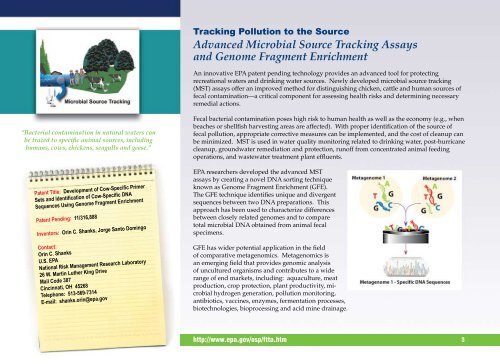FTTA Patent Catalog (PDF) - US Environmental Protection Agency
FTTA Patent Catalog (PDF) - US Environmental Protection Agency
FTTA Patent Catalog (PDF) - US Environmental Protection Agency
Create successful ePaper yourself
Turn your PDF publications into a flip-book with our unique Google optimized e-Paper software.
“Bacterial contamination in natural waters can<br />
be traced to specific animal sources, including<br />
humans, cows, chickens, seagulls and geese.”<br />
<strong>Patent</strong> Title: Development of Cow-Specific Primer<br />
Sets and Identification of Cow-Specific DNA<br />
Sequences Using Genome Fragment Enrichment<br />
<strong>Patent</strong> Pending: 11/316,888<br />
Inventors: Orin C. Shanks, Jorge Santo Domingo<br />
Contact:<br />
Orin C. Shanks<br />
U.S. EPA<br />
National Risk Management Research Laboratory<br />
26 W. Martin Luther King Drive<br />
Mail Code 387<br />
Cincinnati, OH 45268<br />
Telephone: 513-569-7314<br />
E-mail: shanks.orin@epa.gov<br />
Tracking Pollution to the Source<br />
Advanced Microbial Source Tracking Assays<br />
and Genome Fragment Enrichment<br />
An innovative EPA patent pending technology provides an advanced tool for protecting<br />
recreational waters and drinking water sources. Newly developed microbial source tracking<br />
(MST) assays offer an improved method for distinguishing chicken, cattle and human sources of<br />
fecal contamination—a critical component for assessing health risks and determining necessary<br />
remedial actions.<br />
Fecal bacterial contamination poses high risk to human health as well as the economy (e.g., when<br />
beaches or shellfish harvesting areas are affected). With proper identification of the source of<br />
fecal pollution, appropriate corrective measures can be implemented, and the cost of cleanup can<br />
be minimized. MST is used in water quality monitoring related to drinking water, post-hurricane<br />
cleanup, groundwater remediation and protection, runoff from concentrated animal feeding<br />
operations, and wastewater treatment plant effluents.<br />
EPA researchers developed the advanced MST<br />
assays by creating a novel DNA sorting technique<br />
known as Genome Fragment Enrichment (GFE).<br />
The GFE technique identifies unique and divergent<br />
sequences between two DNA preparations. This<br />
approach has been used to characterize differences<br />
between closely related genomes and to compare<br />
total microbial DNA obtained from animal fecal<br />
specimens.<br />
GFE has wider potential application in the field<br />
of comparative metagenomics. Metagenomics is<br />
an emerging field that provides genomic analysis<br />
of uncultured organisms and contributes to a wide<br />
range of end markets, including: aquaculture, meat<br />
production, crop protection, plant productivity, microbial<br />
hydrogen generation, pollution monitoring,<br />
antibiotics, vaccines, enzymes, fermentation processes,<br />
biotechnologies, bioprocessing and acid mine drainage.<br />
http://www.epa.gov/osp/ftta.htm 3

















